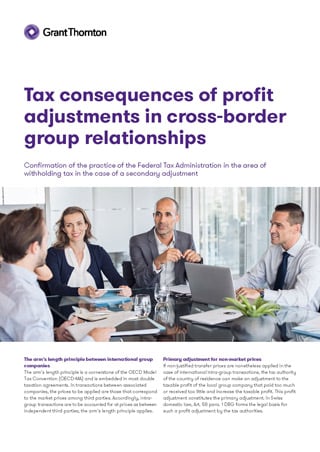-
Audit Industry, Services, Institutions
More security, more trust: Audit services for national and international business clients
-
Audit Financial Services
More security, more trust: Audit services for banks and other financial companies
-
Corporate Tax
National and international tax consulting and planning
-
Individual Tax
Individual Tax
-
Indirect Tax/VAT
Our services in the area of value-added tax
-
Transfer Pricing
Our transfer pricing services.
-
M&A Tax
Advice throughout the transaction and deal cycle
-
Tax Financial Services
Our tax services for financial service providers.
-
Advisory IT & Digitalisation
Generating security with IT.
-
Forensic Services
Nowadays, the investigation of criminal offences in companies increasingly involves digital data and entire IT systems.
-
Regulatory & Compliance Financial Services
Advisory services in financial market law and sustainable finance.
-
Mergers & Acquisitions / Transaction Services
Successfully handling transactions with good advice.
-
Legal Services
Experts in commercial law.
-
Trust Services
We are there for you.
-
Business Risk Services
Sustainable growth for your company.
-
IFRS Services
Die Rechnungslegung nach den International Financial Reporting Standards (IFRS) und die Finanzberichterstattung stehen ständig vor neuen Herausforderungen durch Gesetzgeber, Regulierungsbehörden und Gremien. Einige IFRS-Rechnungslegungsthemen sind so komplex, dass sie generell schwer zu handhaben sind.
-
Abacus
Grant Thornton Switzerland Liechtenstein has been an official sales partner of Abacus Business Software since 2020.
-
Accounting Services
We keep accounts for you.
-
Payroll Services
Leave your payroll accounting to us.
-
Real Estate Management
Leave the management of your real estate to us.
-
Apprentices
Career with an apprenticeship?!

The arm’s length principle between international group companies
The arm’s length principle is a cornerstone of the OECD Model Tax Convention (OECD-MA) and is embedded in most double taxation agreements. In transactions between associated companies, the prices to be applied are those that correspond to the market prices among third parties. Accordingly, intragroup transactions are to be accounted for at prices as between independent third parties; the arm’s length principle applies.
Primary adjustment for non-market prices
If non-justified transfer prices are nonetheless applied in the case of international intra-group transactions, the tax authority of the country of residence can make an adjustment to the taxable profit of the local group company that paid too much or received too little and increase the taxable profit. This profit adjustment constitutes the primary adjustment. In Swiss domestic law, Art. 58 para. 1 DBG forms the legal basis for such a profit adjustment by the tax authorities.
Corresponding adjustment and consequences for income taxes
If a foreign group company is subject to a primary adjustment in relation to a Swiss counterparty and the corrected, increased profit is taxed abroad, an economic double taxation occurs. To avoid multiple taxation, the OECD-MA provides for the possibility of a “corresponding adjustment”. If the amount of the corresponding adjustment corresponds to the taxable profit offset in the other state, this leads to a revised profit allocation in both states. Double taxation may thus be avoided.
The OECD-MA sets the following conditions for a counter adjustment: First, the primary adjustment is made on the basis of the arm’s length principle and second, the increased profits are factually taxed. This must be proven. If the contracting state requested to make a counter-adjustment recognizes the reason and amount of the primary adjustment made by the foreign tax authorities, the counter-adjustment is usually made by adjusting the tax books; nothing happens in the commercial accounts though.
Secondary adjustment and consequences for withholding taxes
As both the primary and the corresponding adjustment are usually considered for tax but not for accounting books, differences result between the commercial and tax books. The aim of the secondary adjustment is to create a situation under commercial law as if correct third-party prices had been applied from the beginning.
If the correction of a final assessment for direct taxes takes place in a revision procedure, after the tax authorities have reached an agreement in a formal mutual agreement procedure, the secondary correction is not subject to withholding tax. This long-standing practice of the Federal Tax Administration was defined and expanded in the Federal Act on the Implementation of International Agreements in the Area of Taxation (StADG), in force since January 2022. In the case of an assessment procedure that is still open, also a secondary adjustment is not subject to withholding tax – provided an agreement between the tax authorities on the correction and the final primary adjustment is proven by the foreign tax authority.
With the entry into force of the StADG, it is now possible to make a domestic tax adjustment without a prior formal mutual agreement procedure. For this purpose, a domestic agreement must be concluded between the competent cantonal tax authority and the State Secretariat for International Financial Matters (SIF). Such an agreement requires the request of the taxpayer to initiate a mutual agreement procedure. If there is a consensus between the competent tax authority and the SIF when examining the request that a correction must be made in Switzerland, a domestic agreement can be concluded and submitted to the taxpayer for approval. An effective intergovernmental mutual agreement procedure is obsolete in such a case. This eliminates an often lengthy process; time and costs can be reduced. Since the domestic agreement is equivalent to an intergovernmental mutual agreement, secondary adjustments made on the basis of a domestic agreement are not subject to withholding tax.
Case study
A company domiciled in the USA (USCo) holds 100% of the shares of a company domiciled in Switzerland (SwissCo). The Swiss company is in turn the sole shareholder of a company domiciled in Germany (DCo). SwissCo is final assessed until and including tax year 2021.

USCo, as the parent company of the Group, is the holder of a patent/IP in a medical sector. Based on a licence agreement with USCo, SwissCo will manufacture a drug in Switzerland from 2022. In addition, SwissCo acts as central entrepreneur/principal for all markets outside the USA and sells the products directly or indirectly via distribution companies. For example, the products are also distributed by the subsidiary DCo in Germany. The intercompany transfer price for the use of the licence by SwissCo was defined as 1% depending on the turnover of the principal. Applying these transfer prices, USCo receives a licence fee of CHF 2m for a turnover of CHF 200m, for example. The US tax authorities take the view that comparable third parties would claim a licence fee of 5%, i.e. CHF 10m, for comparable activities. As a result, they add the difference of CHF 8m to the USCo’s taxable profit.
According to the US tax authorities, USCo charged too little for the use of licences by SwissCo. In doing so, it has granted a hidden advantage to its subsidiary SwissCo. A profit shift to Switzerland is taking place. The amount of CHF 8 million (“primary adjustment”) offset in the USA is subject to income tax in the USA. As the CHF 8m also had already been taxed as profit by SwissCo in Switzerland within the scope of the intercompany charges, there is an economic double taxation to the extent of the CHF 8m.
In the present case the assessment in Switzerland is not final yet, as such, nothing would prevent a corresponding domestic Swiss corresponding-adjustment. In practice, counter-adjustments are permitted if the Swiss tax authority responsible for the assessment recognizes the foreign primary adjustment on the merits and in terms of amount. The counter-adjustment can be made autonomously, provided that it does not imply an abusive transfer pricing or an intentional shifting of expenses to Switzerland.
Due to this primary and corresponding adjustment, a difference arises between the tax and commercial books of SwissCo. By means of a secondary adjustment, the commercial and tax books can be reconciled. This occurs via a repatriation of excess income. Accordingly, the excess profits are effectively refunded through invoicing by USCo to SwissCo.
The refund leads to the entry of a liability or to an outflow of liquidity and is booked as an expense under commercial law. In such a situation, it must be ensured that this secondary adjustment does not trigger any withholding tax consequences, as the FTA could consider the refund of the excess profits to be a payment in kind. According to the FTA, however, no withholding tax is levied even without a prior mutual agreement procedure, provided a domestic agreement between the competent cantonal tax authority and the SIF was reached.
Conclusion
Transfer pricing adjustments in international relations is complex. With its expertise, practical experience and good cooperation with the tax authorities, Grant Thornton Switzerland/Liechtenstein is ideally positioned to provide active support in cross-border transfer pricing adjustments and to settle them in an amicable and tax-efficient manner. We look forward to hearing from you.


